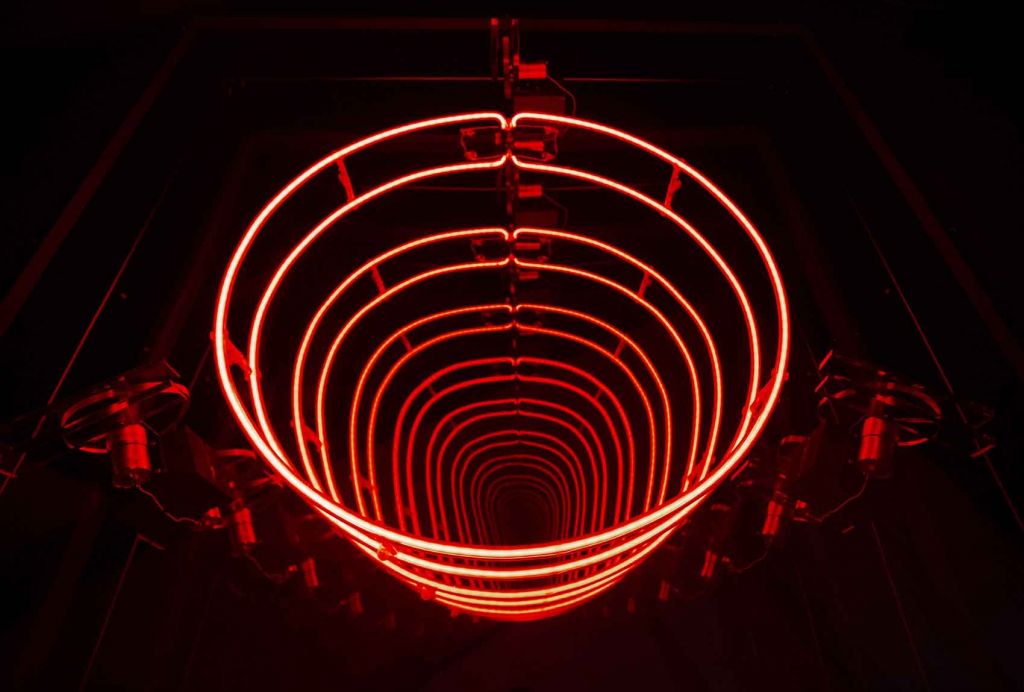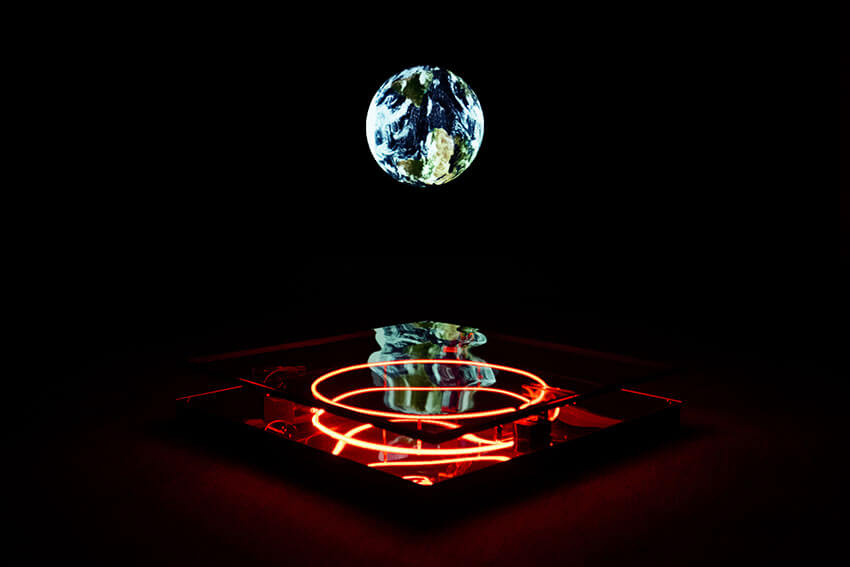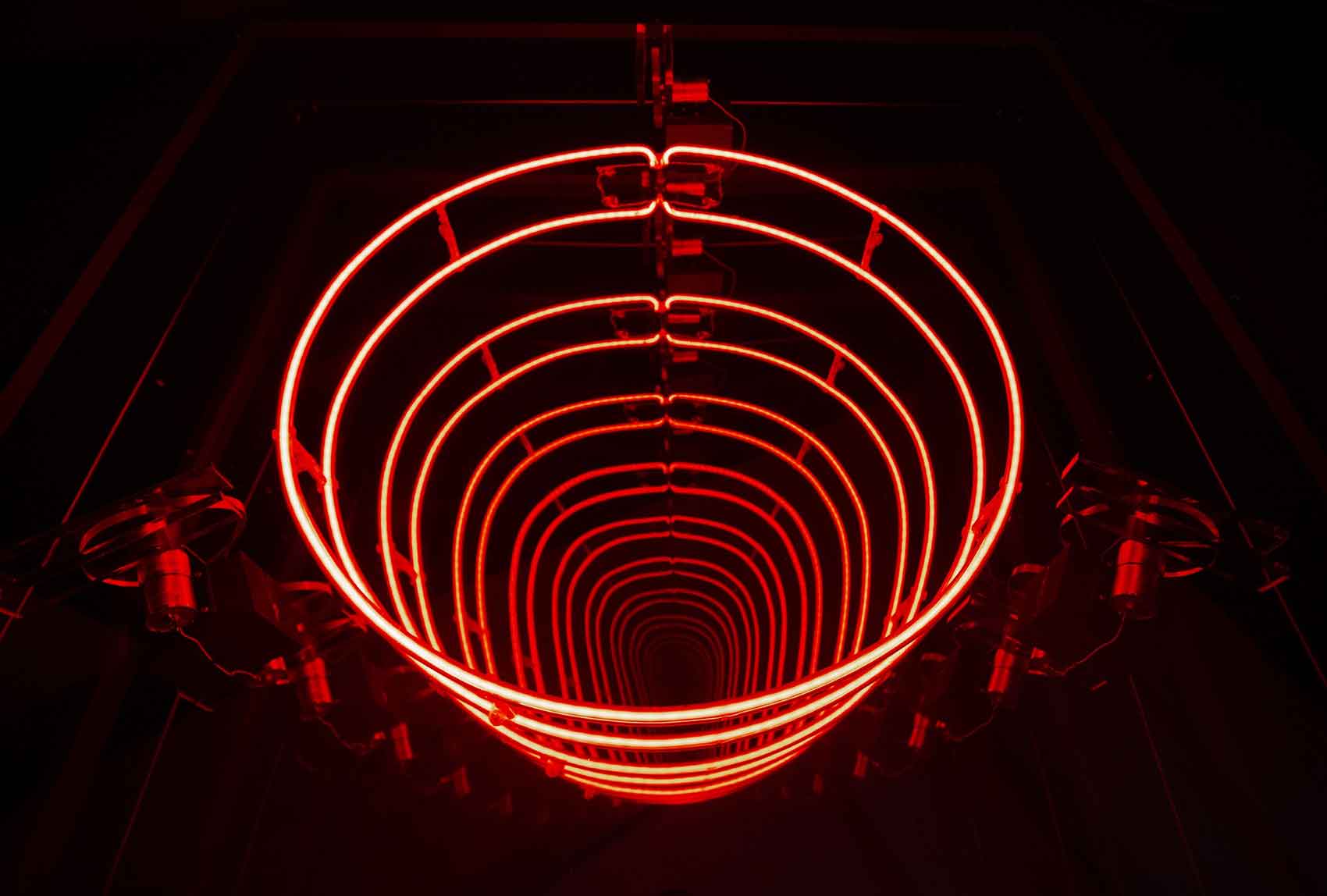Interview by Allan Gardner

Dasha Loyko is an artist and writer currently based in London. Having only just graduated from the Royal College of Art, she has exhibited at the Liverpool Biennial (2018) and coordinated the production and editing of Le Grand K (a 2019 publication), including its launch exhibitions at Gossamer Fog and Science Museum in London. With her first solo show, entitled Resist Science Fiction, Loyko has been given an opportunity to present her work in context with itself and to emphasise the position of connectedness and coincidence within her expanded practice.
Loyko’s work straddles the intersection between science and fiction, flirting with romance and self-projection. Maintaining a double language, her work greets with one hand whilst picking your pocket with another. From Trident to an abstraction of a wormhole, she draws on science’s cultural reference points and imbues them with second meanings, symbols and double entendre.
Maintaining a dry humour throughout, her works poke fun at the seriousness of science whilst simultaneously emphasising the momentousness of love and romance. Very early in Dasha Loyko’s Parody of the Sun (2018), the artist states: “Each thing seen is the parody of another.” This is a clue. It sits at the front of the piece, creating a marker from which the viewer can identify what they’re seeing as being not exactly what it seems. As an artist, she is duplicitous.
Loyko gives the viewers opportunities to let themselves in, engage with the subtext of the work and understand more fully that this surface is only the surface. Information is purely data without the mind unpacking it. Part of what works like Parody tap into is our ability to process this data. Loyko’s background in science (with a BA in the Philosophy of Science) helps her work to recognise the human brain’s propensity to process data based on a set of circumstances.
Soundalikes, errors, rhymes, playing with cadence – all of these techniques bury the data. The information is mitigated by the context in which it is being received. Think of becoming embarrassed: your ears get hot, your face grows red, and maybe you begin to sweat. The circumstances impede the information from being received. Techniques like this are drawn on as a means of corralling sections and separating them into collaborating narratives. The work is coy in the way that it always seems to be alluding to something but is quick enough that we can rarely quite catch it.


Starting with your most recent work, for your grad show at the RCA you produced a wormhole: Resist Science Fiction. For those lucky enough to see the work in July, it was a twisting mechanical tunnel veering off into nothingness. Something I thought was interesting about this work was the physicality of it – typically, a wormhole, or a whirlpool, would suck you in against your will. This was enticing, with the acrylic panel acting almost like a shield, preventing overzealous viewers from tumbling in. What were you hoping to communicate with this work?
I’m interested in the way storytelling affects physical reality. The way scientific theories become spells that are cast on the world and affect the way we interact with it, and so re-scripting those spells allows for a certain re-calibration of that interaction. In this way, the wormhole going through the gallery floor acts as a kind of a body-scale calibration mechanism gyrating in response to my chants against science fiction.
Can you elaborate on ‘chants against science fiction’? I’m also interested in your ‘magic as data’ mantra. Does this reflect the principles of something like chaos magic as it relates to theory becoming a popularly held belief? For example, evolution is a popularly held belief vs something like flat earthers. The proliferation of an idea becomes more powerful through belief and is then embodied – essentially the notion of a Tulpa. I’m also interested in the physical production of the work – I know you coded and crafted the parts yourself. The ‘eggs’, in particular, as giving life to the work. Could you talk a little bit about the process of production?
I referred to it as chants, but it is more of a manifesto. A manifesto against science fiction based on the premise that science is already fiction. I tend to approach theories that I engage within my work as a kind of storytelling, just as playfully and frivolously as I approach speculation, error, or myth.
‘Magic is data’ is the last phrase of the manifesto. For me, it is about the manipulability and de-fetishisation of magic: that it can be quantified and plugged into a spreadsheet, used on a daily basis for something mundane. But it also very much relates to feeding fiction out into the world and generating feedback loops of self-actualisation. Repeating something often enough so that it becomes a reality, spelling a world you’d like to see into existence.
The eggs were an engineering solution that gave the work movement required in order to produce the tunnel illusion. I experimented with various shapes and codes, and it just happened to be the shape that functioned best. Yet they also embody my research into the scientific method that became the lines ‘biology is Sleeping Beauty’ and ‘biology is Prince Charming’. I
was looking specifically at how fictions and various literary tropes enter the allegedly-impartial process of scientific knowledge-making, mostly via metaphor. It was important to me that I arrived at the egg-motor solution purely functionally, and yet I like to think that having had the manifesto in my head for a few months prior to that had something to do with it!
For a practice so deeply entwined with the word ‘science’, I’ve always found your work to have a romantic duality. Everything has a double meaning or a reference with multiple meanings. It weirdly (maybe this is heavily influenced by the inviting wormhole) reminds me of Alice in Wonderland. The work has a source, a reason or a message that can be reached, but you offer up distractions constantly – opportunities for the viewer to go off on a tangent into a new dialogue. What role does romance (personal romance, romantic life etc., as well as the notion of romance) play in your work?
Alice In Wonderland is a perfect reference for approaching my work. Lewis Carroll was a mathematician, and the way he weaves a narrative using logical constructs entangled with accidents, wordplay, and distractions along the way is very much the framework within which my practice operates. In a way, by going off on all these tangents, I embrace my short attention span and allow myself to get carried away. There’s a lot of joy in that.
Romance is often my way in I tend to begin any piece with writing, and I often use personal correspondence as a starting point or write a love letter in order to trigger a chain of associations or develop a personal connection with an idea, a word, or an object I’m working with.
Although what interests me is mathematical and diagrammatic: statistics, measurements – all the stuff that tends to be cold and impersonal – I have a very geeky yet intense desire towards it. So I end up eroticising scientific jargon, romanticising the bureaucratic language of admin.
That stands out to me: ‘romanticising bureaucratic language’ and the notion of having a propensity towards something that’s cold or impersonal.
It was the experience of writing the book that the film was based on* that allowed me to find the playful voice that embraces its own geekiness and susceptibility to distractions. I guess that dense and deadpan writing style does come naturally. I think I more or less speak that way too.
This reminds me of your 2018 work Parody of the Sun. For being delivered as a half-lecture half-Adam Curtis-style documentary, it’s full of dry humour and language verging on double entendre. Even down to the set dressing/outfit in your lecture scenes, it’s just ‘science’ enough but seems to allude constantly to something else. A trick, a joke or a hidden message. How much consideration goes into this language? Is it your natural way of writing to incorporate such dense symbolism and subtext, or is it a more intelligent design?
I’m curious about what can come out of a contradiction. A contradiction is the analytic philosopher’s worst nightmare and also the weapon of choice! Reduce your opponent’s argument to absurdity, and you win. In classical logic, there is a dictum that, from contradiction, anything follows. (As I’m fact-checking myself while writing this, I find out that this is also called the ‘principle of explosion’. Also, I have always enjoyed that experts in logic are called logicians.)
Technically, anything in the world can be inferred from a contradiction. For example, if all apples are red and all apples are not red, then there is life on Mars is a valid logical inference. I’m very attached to logical paradoxes and also to how much logic is intertwined with language. Often a logical paradox is entirely a linguistic one.
Contradictions is an interesting word in relation to your practice, but also to coincidence. The ‘principle of explosion’ is a perfect example, a notion that’s present in your practice having a synonym relating directly to another work – WMD. It’s similar to your work with the nuclear-missile-sex toy. Or maybe the comparisons I’m drawing come from coincidence and contradiction sounding similar? maybe this is your duplicitous nature? The principle of explosion enacted. Spooky stuff. Can we talk a little about LGK? It’d be nice to hear you expand on your motivation for doing this and for bringing the artists together for the project – what you sought to achieve.
Coincidence is a major generative principle in my work. In fact, so much so that, together with artist Emma Finn, we are setting up a research lab called for artists who work with narrative devices and storytelling called Coincidence Control. When I first came across the news about the planned changes to the metric system, about 7 months before World Metrology Day, I was immediately obsessed with the physical-to-linguistic shift that would be enacted through the dematerialisation of the kilogram. I knew that it needed a celebration – some kind of a response, a piece of writing, or at least a party, to bury the old kilo with fanfare.
This escalated very quickly after I invited Károly Tendl and Andrea Khôra to form an editorial/curatorial team with me. We ended up with an anthology of responses to the shift by 27 artists and writers and two farewell parties. In fact, speaking of coincidence, the permanent display in the Winton Gallery, the space where we held our second live event at the Science Museum, consists of a number of cabinets of former weight and measurement standards from all around the world: metal rods and balls much like our own Le Grand K. This was their only available gallery for the night when we were invited to perform.
Motivated by the desire for ever-increasing precision, there was something ridiculous and strangely invasive about the redefinition of the kilogram that took place on May 20. The simple gesture of unanchoring the measurement unit from its localised physicality and turning it into a set of instructions has triggered a chain of responses about ritual, linguistic shifts, the colonial aspects of measurement, and bureaucracy, as well as wider exploration of metaphor, standardisation, and value.
What excited me about the metric system shift was the combination of its formal elegance with its conceptual entrenchment in complex political, scientific, and fictional narratives and agendas. Also, the ability to change something’s material state through a change in its definition relates to what we spoke about earlier about fiction and casting spells.






